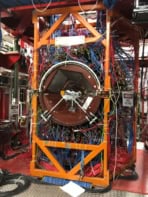
Independent measurements of the charge radius of the helium-3 nucleus using two different methods have yielded significantly different results – prompting a re-evaluation of underlying theory to reconcile them. The international CREMA Collaboration used muonic helium-3 ions to determine the radius, whereas a team in the Netherlands used a quantum-degenerate gas of helium-3 atoms.
The charge radius is a statistical measure of how far the electric charge of a particle extends into space. Both groups were mystified by the discrepancy in the values – which hints at physics beyond the Standard Model of particle physics. However, new theoretical calculations inspired by the results may have already resolved the discrepancy.
Both groups studied the difference between the charge radii of the helium-3 and helium-4 nuclei. CREMA used muonic helium ions, in which the remaining electrons replaced by muons. Muons are much more massive than electrons, so they spend more time near the nucleus – and are therefore more sensitive to the charge radius.
Shorter wavelengths
Muonic atoms have spectra at much shorter wavelengths than normal atoms. This affects values such as the Lamb shift. This is the energy difference in the 2S1/2 and 2P1/2 atomic states, which are split by interactions with virtual photons and vacuum polarization. This is most intense near the nucleus. More importantly, a muon in an S orbital becomes more sensitive to the finite size of the nucleus.
In 2010, CREMA used the charge radius of muonic hydrogen to conclude that the charge radius of the proton is significantly smaller than the current accepted value. The same procedure was then used with muonic helium-4 ions. Now, CREMA has used pulsed laser spectroscopy of muonic helium-3 ions to extract several key parameters including the Lamb shift and used them to calculate the charge radius of muonic helium-3 nuclei. They then calculated the difference with the charge radius in helium-4. The value they obtained was 15 times more accurate than any previously reported.
Meanwhile, at the Free University of Amsterdam in the Netherlands, researchers were taking a different approach, using conventional helium-3 atoms. This has significant challenges, because the effect of the nucleus on electrons is much smaller. However, it also means that an electron affects the nucleus it measures less than does a muon, which mitigates a source of theoretical uncertainty.
The Amsterdam team utilized the fact that the 2S triplet state in helium is extremely long-lived. ”If you manage to get the atom up there, it’s like a new ground state, and that means you can do laser cooling on it and it allows very efficient detection of the atoms,” explains Kjeld Eikema, one of the team’s leaders after its initial leader Wim Vassen died in 2019. In 2018, the Amsterdam group created an ultracold Bose–Einstein condensate (BEC) of helium-4 atoms in the 2S triplet state in an optical dipole trap before using laser spectroscopy to measure the ultra-narrow transition between the 2S triplet state and the higher 2S singlet state.
Degenerate Fermi gas
In the new work, the researchers turned to helium-3, which does not form a BEC but instead forms a degenerate Fermi gas. Interpreting the spectra of this required new discoveries itself. “Current theoretical models are insufficiently accurate to determine the charge radii from measurements on two-electron atoms,” Eikema explains. However, “the nice thing is that if you measure the transition directly in one isotope and then look at the difference with the other isotope, then most complications from the two electrons are common mode and drop out,” he says. This can be used to the determine the difference in the charge radii.
The researchers obtained a value that was even more precise than CREMA’s and larger by 3.6σ. The groups could find no obvious explanation for the discrepancy. “The scope of the physics involved in doing and interpreting these experiments is quite massive,” says Eikema; “a comparison is so interesting, because you can say ‘Well, is all this physics correct then? Are electrons and muons the same aside from their mass? Did we do the quantum electrodynamics correct for both normal atoms and muonic atoms? Did we do the nuclear polarization correctly?’” The results of both teams are described in Science (CREMA, Amsterdam).
While these papers were undergoing peer review, the work attracted the attention of two groups of theoretical physicists – one led by Xiao-Qiu Qi f the Wuhan Institute of Physics and Mathematics in China, and the other by Krzysztof Pachucki of the University of Warsaw in Poland. Both revised the calculation of the hyperfine structure of helium-3, finding that incorporating previously neglected higher orders into the calculation produced an unexpectedly large shift.

Has the proton radius puzzle been solved at last?
“Suddenly, by plugging this new value into our experiment – ping! – our determination comes within 1.2σ of theirs,” says Eikema; “which is a triumph for all the physics involved, and it shows how, by showing there’s a difference, other people think, ‘Maybe we should go and check our calculations,’ and it has improved the calculation of the hyperfine effect.” In this manner the ever improving experiments and theory calculations continue to seek the limits of the Standard Model.
Xiao-Qiu Qi and colleagues describe their calculations in Physical Review Research, while Pachucki’s team have published in Physical Review A.
Eikema adds “Personally I would have adjusted the value in our paper according to these new calculations, but Science preferred to keep the paper as it was at the time of submission and peer review, with an added final paragraph to explain the latest developments.”
Theoretical physicist Marko Horbatsch at Canada’s York University is impressed by the experimental results and bemused by the presentation. “I would say that their final answer is a great success,” he concludes. “There is validity in having the CREMA and Eikema work published side-by-side in a high-impact journal. It’s just that the fact that they agree should not be confined to a final sentence at the end of the paper.”



